- For the quest, see Alduin's Wall (Quest).
Alduin's Wall is a large Akaviri mural found within Sky Haven Temple, dating back to the First Era.[1] It is considered to be one of the best preserved examples of early Akaviri sculptural relief, as well as a wonder of the ancient world.[2]
Alduin's Wall depicts several key events through the history of Tamriel, such as the Dragon War, Jagar Tharn's rule and the Staff of Chaos, the activation of the Numidium and the Warp in the West, the fall of the Tribunal and the eruption of the Red Mountain, the Oblivion Crisis, the Skyrim Civil War and the return of Alduin, the World-Eater.
By game[]
History[]
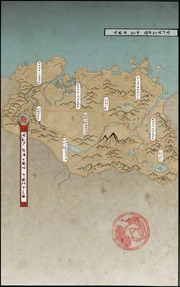
Ancient Akaviri map showing the location of Sky Haven Temple.
Emperor Reman II permitted the construction of Alduin's Wall in 1E 2812. Its purpose was to concisely commit to record all of the dragonlore the Akaviri Dragonguard had accumulated over the course of their existence, and to preserve this knowledge against the forgetfulness of the ages. Given that the return of Alduin was inevitable, the Dragonguard constructed Alduin's Wall as a timeless message and a warning to all generations that were to follow.
Akaviri craftsmen and artisans from Blade temples across the Empire were called upon to labor on the Wall, and after six years it was completed. Reman II visited the Sky Haven Temple complex to officially commemorate the monument's construction, and the Blood Seal at the temple's entrance was consecrated in the presence of Reman II and all the Akaviri Dragonguard of Skyrim. This allowed the temple to be sealed, only to ever be opened again by the blood of a Dragonborn.[1]
Despite being a wonder of the ancient world and the grave reasons for its construction, the location of Alduin's Wall slowly became lost over the passage of the countless centuries, and its very existence, ironically, was forgotten by almost all in the world.[2]
Quests[]
Alduin's Wall[]
The Dragonborn must venture to Karthspire, where they will meet Delphine and Esbern. After venturing past the Forsworn occupying Karthspire Camp, they can enter Sky Haven Temple, the last refuge of the Blades. It is here they find the Prophecy of the Dragonborn, carved unto Alduin's Wall.
Prophecy of the Dragonborn[]
The Prophecy of the Dragonborn has been said to originate in an Elder Scroll, although it is sometimes also attributed to ancient Akaviri wisemen.[3] The left and central sections of Alduin's Wall depict the historic events of the Dragon War and the banishment of Alduin by the ancient Nord heroes. The right section of the Wall foretells of five key historical events that will preface Alduin's return after his expulsion from the world. These include, from left to right:[4]
When misrule takes its place at the eight corners of the world
When the Brass Tower walks and Time is reshaped
When the thrice-blessed fail and the Red Tower trembles
When the Dragonborn Ruler loses his throne, and the White Tower falls
When the Snow Tower lies sundered, kingless, bleeding
The World-Eater wakes, and the Wheel turns upon the Last Dragonborn.
The Dragon War[]
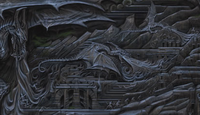
The left section of the Wall narrates how thousands of years ago, lost in the uncounted centuries of the Merethic Era which came before recorded history, the Dragons were ravaging the land, waging war against the races of Men and driving them before the might of their Voice. The humans could not stand against such a force. Some among them would come to worship the Dragons, but all feared them. For the first of three times, Alduin, the World-Eater is depicted.
Alduin's Banishment[]
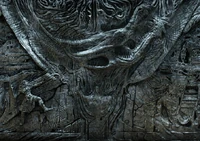
The goddess Kyne took pity on the broken hearts of Men, and intervened by granting mortals the ability to speak as Dragons do.[5] The large central relief of the Wall portrays Alduin's initial downfall to the courage and tenacity of the champions of Men; the three ancient Nord heroes who were the first and mightiest of the Tongues: Felldir the Old, Hakon One-Eye and Gormlaith Golden-Hilt, who used the combined power of the Thu'um and the Elder Scrolls to shout Alduin from the world and cast him adrift in the currents of time.
The Staff of Chaos[]
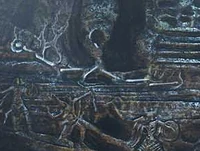
"When misrule takes its place at the eight corners of the world..."
The right section of the Wall prophesies of five key historical events that foreshadow the World-Eater's return. The first of these events presaged by the prophecy is the shattering of the Staff of Chaos, an event depicted in The Elder Scrolls: Arena.
The Staff of Chaos was a powerful relic that could open gateways to other worlds and obliterate all living beings. The Imperial battlemage Jagar Tharn used this mysterious artifact to imprison the Emperor Uriel Septim VII within the realm of Oblivion, after which he broke it into eight pieces and scattered them across Tamriel; events transcribed unto Alduin's Wall centuries before they had come to pass.
Numidium and the Warp in the West[]
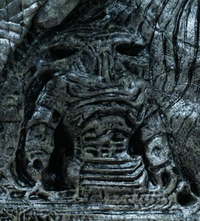
"When the Brass Tower walks and Time is reshaped..."
The depiction of Numidium walking upon Tamriel is the second event in the prophecy that augurs Alduin's return. The massive brass golem, Numidium, was reassembled during the events of The Elder Scrolls II: Daggerfall. The branching choices that determined who would control Numidium resulted in the Warp in the West, a strange occurrence within the Iliac Bay region which paradoxically allowed for all possible outcomes to happen simultaneously.
This event dramatically altered the nature of the world, and brought about a Dragon Break: An unexplainable occurrence that forces a realignment of time and space in reaction to circumstances which render a normal continuity of reality impossible—in this case, the activation of Numidium.
The Disaster at Red Mountain[]
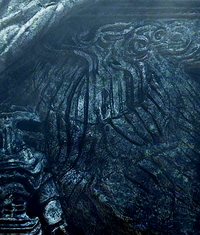
"When the thrice-blessed fail and the Red Tower trembles..."
- Main article: Nerevarine Prophecy
The third segment of the prophecy presages the "failure of the thrice-blessed," and foretells of the fate that would befall the Dunmeri Tribunal at the hands of the Nerevarine, as portrayed in The Elder Scrolls III: Morrowind.
The Tribunal consisted of the three Dunmer gods: Vivec, Almalexia and Sotha Sil who acquired their immortality and powers through the Heart of Lorkhan. They lost their immortality after the Heart was destroyed by the Nerevarine.
The Oblivion Crisis[]
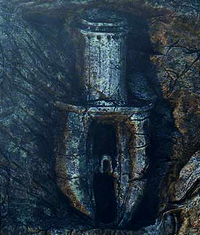
"When the Dragonborn Ruler loses his throne, and the White Tower falls..."
- Main article: Oblivion Crisis
The fourth historic event foretold by the prophecy is the death of emperor Uriel Septim VII, leading Tamriel into the Oblivion Crisis as portrayed in The Elder Scrolls IV: Oblivion.
A previously unknown heir to Uriel Septim VII, known as Martin Septim, was, along with the help of the Hero of Kvatch, able to seal the gates to Oblivion in the darkest hours of the Oblivion Crisis. However, by destroying the Amulet of Kings and sacrificing himself to prevent the Empire's annihilation at the hands of the Daedra hordes, Martin Septim inadvertently brought about the demise of Tiber Septim's bloodline, ending the historical rule of the Dragonborn emperors over Tamriel.
The fall of the White Tower predicts the capturing and sacking of the White-Gold Tower after the siege of the Imperial City, a dramatic series of events that transpired during The Great War between the Empire and the Aldmeri Dominion.
The Civil War[]
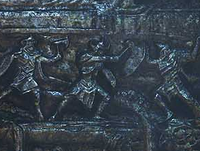
"When the Snow Tower lies sundered, kingless, bleeding..."
- Main article: Skyrim Civil War
The final of events, prophesied to herald the ultimate return of the World-Eater, is the Civil War in Skyrim. As The Elder Scrolls V: Skyrim begins, High King Torygg of Skyrim has been killed by Jarl Ulfric Stormcloak, leaving the province without a unifying leader after the region was plunged into civil war.
Many within the northern province argue Skyrim ought to secede from the Empire, which has lost its Dragonborn rulers with the fall of the Septim Dynasty; additionally, it is beset by corruption and intrigues and has become subject to the dictates of the Aldmeri Dominion in exchange for a tenuous peace. Other Nords refuse to recant their belief that the Empire and its legacy are still worth fighting for, and view the calls for secession as tantamount to high treason. Armed conflict between the two factions becomes inevitable.
The Throat of the World[]
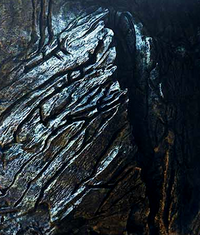
- Main article: Throat of the World
The highest mountain in all of Tamriel, called the Throat of the World, also known as the "Snow-Throat," and alleged to be the site of the birth of Men at the end of the Dawn Era according to the most ancient of legends, houses High Hrothgar; the monastery of the Greybeards. Here on Alduin's Wall, as part of the relief that pictures the prophecy's final segment, the Throat of the World is depicted as cleft in half, symbolizing how Skyrim will tear itself apart.
Hope[]
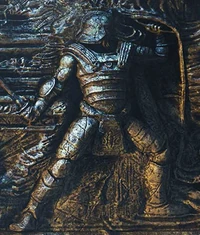
"...the World-Eater wakes, and the Wheel turns upon the Last Dragonborn."
The prophecy that is related through Alduin's Wall is dire, but it is not without hope. For one individual, gifted by Akatosh with the same incredible powers held by the Dragons themselves, has been foretold to become Alduin's Doom and the Savior of Men.
The warriors pictured adjacent to the Dragonborn's relief are the original members of the Dragonguard, the legendary cabal of Akaviri dragon slayers, who are shown to bow before the Dovahkiin and who raise their blades in triumph at his side. For millennia, the Dragonguard have endeavored to protect those they consider Dragonborn in their anticipation of this final moment of prophecy, when on the eve of Alduin's fateful return, the last of the Dragonblood arises to stand against the World-Eater.



